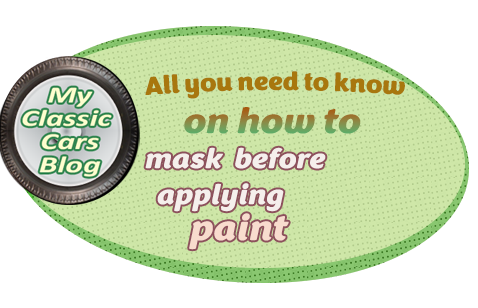 Masking localised areas or the entire vehicle under restoration before respraying can be both time-consuming and very exasperating , yet one that needs to be taken seriously.
Masking localised areas or the entire vehicle under restoration before respraying can be both time-consuming and very exasperating , yet one that needs to be taken seriously.
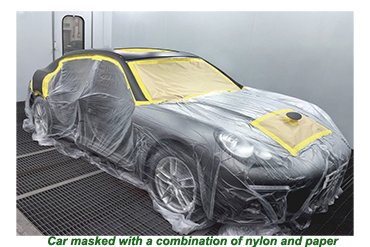 Although masking takes time to master, this does not mean that the novice cannot make a good job of it. Anyone can mask effectively, though perhaps not as quickly or as neatly as the professional who has been doing the same job for years.
Although masking takes time to master, this does not mean that the novice cannot make a good job of it. Anyone can mask effectively, though perhaps not as quickly or as neatly as the professional who has been doing the same job for years.
Masking is one of the few phases in a painting project that if something goes wrong, very little damage can be done that can’t be rapidly put right.
That doesn’t mean cutting corners. Masking a car is far from rocket science, and all that is required is to learn the basics and keep focused.
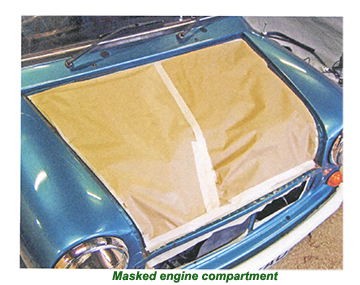 In a full respray, there can often be two full maskings required –first when the base coat is applied and again with a clear coat, which will usually extend beyond the basecoat.
In a full respray, there can often be two full maskings required –first when the base coat is applied and again with a clear coat, which will usually extend beyond the basecoat.
 The traditional method of masking an entire vehicle was always plastic sheeting. The sheeting was laid over the car with the plastic around the areas to be painted cut out.
The traditional method of masking an entire vehicle was always plastic sheeting. The sheeting was laid over the car with the plastic around the areas to be painted cut out.
The areas to be repaired are then lined with a width of paper to prevent the likelihood of the plastic sheeting beginning to shed the paint once it has dried, resulting in dried flecks landing on the newly applied paint.
If a partial respray is all that is necessary, proper masking will allow individual panels to be isolated, making life easier for the spray painter.
On the other hand, masking all of these fiddly areas around the car will represent a real challenge.
![]()
All that is required for localised repairs is to rough mask the primer area to limit overspray, although it is essential to remove any hard edges on the primer that will build up along the masking line.
The easiest way to get started with masking up is to run a line of tape around the area to be painted, always paying particular attention to the inside edge of the tapeline.
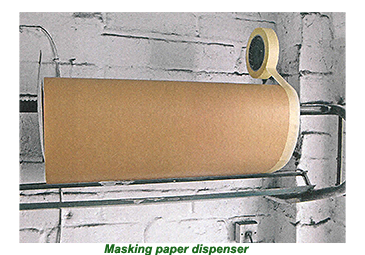 Any deviating from the line will result in paint either being sprayed where it should not have or not being sprayed where it should.
Any deviating from the line will result in paint either being sprayed where it should not have or not being sprayed where it should.
In cases where a false edge is required, the outline masking needs to be set slightly outside of the actual outline of the job, allowing the wet paint edge to fall back onto the panel.
The terms hard edge and soft edge in spray painting describe two different ways in which a surface can be painted.
Hard edge describes when the edge of a panel is well defined, while a soft edge is when the paint is applied to gradually fade into the background.
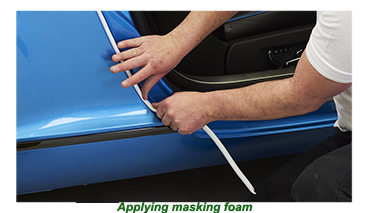 Once the tape outline has been completed, the next stage is to begin sheeting with paper.
Once the tape outline has been completed, the next stage is to begin sheeting with paper.
Old newspapers were always the first choice for those looking to cut costs.
In time using newspapers was found to be a false economy, with the arrival of the option of paper that came in large rolls. Paper rolls, while costing money, were so much easier to work with, making them more cost-effective, especially if there is an apron taper in the vicinity.
Effective sheeting is best achieved if a line of tape is applied to one edge of the paper in the same manner as the apron taper.
![]()
Once again, tidiness will prove to be a virtue, with tight masking attracting less dust than one that includes crumpled paper and ragged edges.
Where corners or tricky shapes are being worked on, the paper will need to be folded and flattened against the bodywork. Any creases will have to be taped (to prevent dust traps),
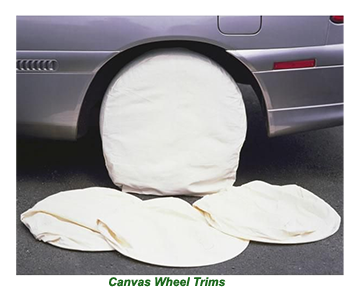 One very handy product to have around is masking foam, explicitly designed for door apertures. This stuff is sticky along one side only and allows the door to be re-opened and shut after masking.
One very handy product to have around is masking foam, explicitly designed for door apertures. This stuff is sticky along one side only and allows the door to be re-opened and shut after masking.
 Many tape techniques for closed doors involve effectively sealing the door closed.
Many tape techniques for closed doors involve effectively sealing the door closed.
When window glass is being left in place, the rubber needs to be masked out without the paint bridging over and onto it.
The best way to achieve a neat finish, with no chance of bridging, is to fit a length of wire under the lip of the rubber.
Wheels are also in need of protection from overspray and do not always readily adhere to the tape.
 Various options for wheel masking are available to the home enthusiast without the expense of proprietary items, with most experienced painters opting for masking the wheels in paper, cardboard or even canvas wheel trims.
Various options for wheel masking are available to the home enthusiast without the expense of proprietary items, with most experienced painters opting for masking the wheels in paper, cardboard or even canvas wheel trims.
All of these options are readily available online.
With every area that need not be painted neatly masked, the time has come to push the vehicle into the paint booth for the next stage.
pw3

